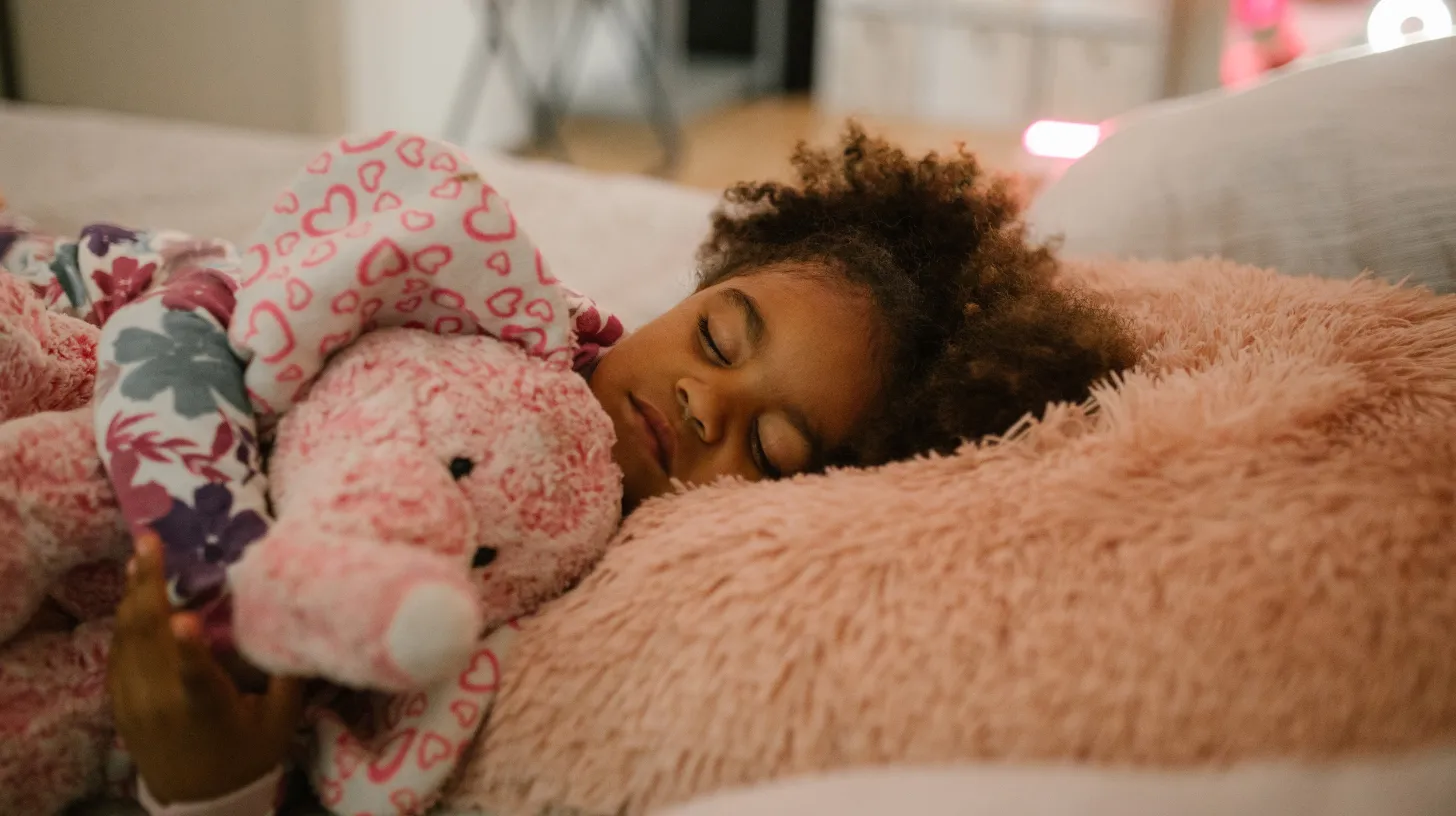As parents, finding the right child sleep solutions can be a challenging and exhausting task. With so many factors affecting your child’s ability to fall asleep and stay asleep, it is crucial to understand the root causes of their sleep issues to address them effectively.
In this guide, we will examine the sources of sleep issues in children and explore methods to encourage independent sleeping habits.
We begin by exploring common causes of sleep problems in children and how anxiety or stress may contribute to these difficulties.
Next, we discuss behavioural techniques for fostering independent sleeping habits through gradual withdrawal methods and establishing consistent bedtime routines.

Furthermore, creating an ideal sleep environment is essential for proper rest; thus, we examine temperature control and bedding selection while addressing technology limitations that reduce distractions.
Calming pre-bedtime activities such as mindfulness practices are also explored as effective tools for enhancing overall sleep quality.
For more complex cases involving insomnia, cognitive-behavioural therapy (CBT) techniques may prove beneficial – our guide provides an overview of these strategies alongside information on finding qualified therapists who specialise in child sleep solutions.
Finally, maintaining a regular schedule with consistent bedtimes and wake-up times is paramount for long-term success; we offer tips on adapting schedules during weekends or school breaks to ensure continued progress.
Table of Contents:
- Understanding Your Child’s Sleep Struggles
- Behavioural Techniques for Independent Sleeping
- Creating an Ideal Sleep Environment
- Calming Pre-Bedtime Activities
- Behavioural Therapy (CBT) for Insomnia
- Establishing and Maintaining a Sleep Schedule
- FAQs in Relation to Child Sleep Solutions
- Conclusion
Understanding Your Child’s Sleep Struggles
Identify the source of your child’s sleep struggles to address them effectively. Consider factors such as anxiety, bedtime routines, and environmental disturbances that may contribute to their difficulty falling or staying asleep.
Identifying common causes of sleep problems in children
Sleep problems can stem from various sources, including poor sleep hygiene, irregular schedules, and medical conditions like pediatric obstructive sleep apnea. CPAP machines are one effective sleep solution you might want to consider for your child.
Younger kids may struggle with being apart from caregivers or be scared of the dark, whereas adolescents could experience tension due to school assignments and social issues. It’s also important to consider whether your child eats too close to bedtime or consumes caffeine through energy drinks and certain foods.
Recognizing signs of anxiety or stress affecting sleep
Anxiety and stress can manifest differently in each child. Still, they may include symptoms such as trouble falling asleep, frequent night waking, nightmares, excessive worry about going to bed, and resistance towards a consistent bedtime routine.
If you suspect these feelings are also hindering your child’s development during the day – for example, if they are more irritable than usual – it might be time for a conversation with their paediatrician.
To help alleviate some of this tension before bed, try incorporating calming activities into their evening schedule, like reading together quietly under soft lighting, listening to soothing music (preferably without lyrics), and engaging in gentle stretching exercises which promote relaxation muscles throughout the body.
And practising deep breathing techniques designed to reduce overall physical and mental strain levels.
As a parent, being patient and empathetic is crucial when addressing your child’s sleep struggles. By understanding the root causes of their issues and implementing appropriate solutions, you can help them achieve better rest and support their overall well-being.
To effectively address a child’s sleep issues, it is essential to identify the underlying reasons behind them such as anxiety, bedtime routines and environmental disturbances. Sleep problems can stem from various sources including poor sleep hygiene, irregular schedules and medical conditions like sleep apnea. By understanding the root causes of their issues and implementing appropriate solutions, parents can help their children achieve better rest and support their overall well-being.
Behavioural Techniques for Independent Sleeping
Encourage your child to develop healthy sleeping habits by gradually implementing behavioural techniques to promote independence during bedtime. This can include transitioning from lying in bed with them to sitting on a chair nearby until they fall asleep.
Gradual Withdrawal Method for Fostering Independent Sleep
The gradual withdrawal method is an effective approach that helps children feel more secure and confident as they learn to sleep independently.
Start by lying down next to your child, then move closer to the bed’s edge each night. Eventually, you’ll transition into sitting on a chair beside their bed until they can fall asleep without your presence.
Establishing Consistent Bedtime Routines and Schedules
A consistent bedtime routine is essential in helping younger children establish proper sleep patterns.
Ensure you follow a predictable sequence of events leading up to bedtime, such as bath time, brushing teeth, reading a story or listening to calming music (source). Creating and sticking to a regular schedule will help signal when it’s time for your child’s body and mind to feel sleepy.
- Create visual cues: Post the schedule somewhere visible so everyone knows what comes next in the routine.
- Maintain consistency: Follow this routine every night, even on weekends, to reinforce its effectiveness.
- Foster relaxation: Incorporate activities like quiet time or deep breathing exercises before lights out (more ideas can be found at Sleep Foundation).
- Monitor screen time: Limit exposure to screens at least an hour before bedtime, as the blue light emitted can interfere with your child’s ability to fall asleep.
By implementing these behavioural techniques and fostering a consistent bedtime routine, you’ll be well on your way towards helping your child overcome their sleep issues and enjoy a more restful night’s sleep.
Creating an Ideal Sleep Environment
A comfortable and calming bedroom environment is crucial in helping kids who have trouble sleeping. Consider incorporating elements like room-darkening curtains, noise-cancelling headphones, eye masks, and weighted blankets into their space for optimal relaxation.
Importance of Temperature Control and Proper Bedding Selection
Having the right temperature in your kid’s bedroom is necessary for an adequate night of rest. Experts recommend keeping the room between 16-20°C (60-68°F) to help children feel sleepy at bedtime.
Additionally, selecting appropriate bedding materials, such as breathable cotton sheets, can create a cosy sleep environment.
Reducing Distractions Through Technology Limitations
- Limited screen time: Encourage your child to avoid using electronic devices such as smartphones or tablets at least one hour before bedtime since exposure to blue light emitted from screens can interfere with melatonin production – the hormone responsible for inducing sleepiness.
- No TVs or computers in bedrooms: Keep these devices out of your child’s sleeping area so they are not tempted to use them when it is time for bed.
- Soothing sounds: If needed, consider playing calming music or white noise machines that emit soothing sounds like ocean waves or raindrops falling on leaves during quiet time before bed (NHS recommends this approach) instead of watching TV shows or videos online, which may overstimulate younger children.
Incorporating these strategies into your child’s bedroom will create an ideal sleep environment that promotes relaxation and minimizes distractions.
Addressing factors such as room temperature, bedding materials, and technology usage can help your child overcome sleep issues and enjoy a more peaceful bedtime routine.
Calming Pre-Bedtime Activities
Engaging your child in relaxing activities before bed can help ease the transition into a restful slumber. It is essential to create a peaceful bedtime routine that allows them to wind down and feel sleepy rather than wide awake from stimulating activities.
Benefits of Mindfulness Practices for Better Sleep Quality
Mindfulness techniques, like meditation and deep breathing activities, have been proven advantageous for better sleep quality in younger and older children.
Focusing on the present moment can help your child relax and drift off to sleep more easily. You can start with simple guided meditations or calming music specifically designed for kids’ relaxation.
Avoiding Stimulating Activities Close to Bedtime
- Limited screen time: Ensure that electronic devices are turned off at least an hour before bedtime since screens emit blue light, suppressing melatonin production – a hormone responsible for regulating sleep cycles.
- No heavy meals: Ensure your child eats dinner early enough so they don’t go to bed feeling too full or hungry. Avoid giving them energy drinks or caffeinated beverages close to bedtime, as these may disrupt their ability to fall asleep.
- Gentle physical activity: Encourage quiet time with gentle stretching exercises like yoga instead of vigorous exercise right before bed. This helps relax muscles without increasing heart rate and adrenaline levels, allowing your child’s body clock (circadian rhythm) to more easily adjust towards proper sleep patterns.
Incorporating calming activities into a consistent pre-bedtime routine can facilitate better sleep for your child. Remember that consistency is key, so make sure these activities become a regular part of your child’s bedtime ritual for optimal results.
Behavioural Therapy (CBT) for Insomnia
Cognitive Behavioural Therapy (CBT) has proven beneficial for children struggling with insomnia by addressing cognitive aspects (thoughts about sleep) and behavioural components that interfere with healthy sleeping patterns.
CBT helps kids develop skills necessary for achieving independent slumber without relying on external aids or parental presence.
Overview of CBT Techniques for Improving Sleep in Children
Some common techniques used in CBT to improve sleep include:
- Sleep hygiene education: Teaching children the importance of maintaining a consistent bedtime routine, creating an ideal sleep environment, and avoiding stimulating activities before bed.
- Sleep restriction therapy: Limiting time spent in bed to match the child’s actual amount of sleep, which can help consolidate their rest and reduce instances of waking up during the night. Gradually increasing time in bed as needed once improvements are seen.
- Cognitive restructuring: Identifying and challenging negative thoughts related to sleep, such as anxiety or fear around falling asleep or staying asleep. This can be done through guided discussions with a therapist or using self-help resources like books on overcoming insomnia.
- Relaxation training: Incorporating calming techniques such as deep breathing exercises, progressive muscle relaxation, meditation, or listening to calming music before bedtime.
Finding a Qualified Therapist to Guide Your Child Through the Process
For a qualified CBT therapist, BABCP is an excellent resource to help locate one near you; also, consider recommendations from your child’s paediatrician or other healthcare professionals.
The British Association for Behavioural and Cognitive Psychotherapies (BABCP) is an excellent resource to help you locate a certified CBT practitioner near you. Additionally, consider seeking recommendations from your child’s paediatrician or other healthcare professionals.
Patience and perseverance are key to helping your child find the best sleep solutions. Many children can overcome their sleep problems and enjoy more restful nights with patience, persistence, and professional guidance.
Establishing and Maintaining a Sleep Schedule
Crucial for aiding kids who have difficulty sleeping is the necessity of uniformity. Creating and adhering to a posted sleep schedule can provide structure, predictability, and reassurance for parents and children as they work towards better nights of rest.
Importance of Regular Bedtimes and Wake-up Times
Establishing regular bedtimes and wake-up times is crucial in promoting healthy sleep habits for your child. A consistent bedtime routine helps signal the body that it’s time to wind down, making it easier for them to fall asleep.
Similarly, waking up at the same time each day aids in regulating their internal clock or circadian rhythm. This consistency not only improves your child’s ability to fall asleep but also enhances their overall quality of sleep.
Adapting Schedules During Weekends or School Breaks
Maintaining a consistent sleep schedule may be challenging during weekends or school breaks when routines shift.
However, sticking as closely as possible to your child’s established bedtime routine will help prevent disruptions in their circadian rhythm, which could lead to poor sleep quality or difficulty falling asleep once school resumes.
- Create boundaries: Set limits on how late your child stays up during weekends or holidays by allowing them an extra hour past their usual bedtime rather than letting them stay awake indefinitely.
- Avoid excessive napping: Encourage outdoor activities during daylight hours to keep your child active and engaged, reducing the likelihood of long naps that could interfere with their nighttime sleep.
- Monitor diet: Be mindful of what your child eats, especially in the evenings. Limit caffeine intake from sources like chocolate or energy drinks, making it harder for them to feel sleepy at bedtime.
Incorporating these strategies will help maintain a consistent sleep schedule for your child, ensuring they receive proper rest and support their overall development.
FAQs in Relation to Child Sleep Solutions
What is a possible solution to help kids get more sleep?
Establishing a consistent bedtime routine and schedule is an effective solution for helping children get more sleep.
This includes setting regular bedtimes, creating an ideal sleep environment, engaging in calming pre-bedtime activities, and gradually fostering independent sleeping habits.
Additionally, limit exposure to screens before bedtime as they can interfere with the natural production of melatonin.
How do you treat sleep deprivation in children?
Treating sleep deprivation in children involves addressing the underlying causes, such as stress or anxiety, implementing healthy sleep habits like maintaining a consistent schedule and reducing screen time before bed.
In some cases, cognitive-behavioural therapy (CBT) may be beneficial for improving your child’s quality of rest by targeting negative thoughts and behaviours associated with insomnia.
What is the recommendation for sleep duration in children?
The recommended amount of sleep varies depending on your child’s age. For example, toddlers (1-2 years) need 11-14 hours; preschoolers (3-5 years) require 10-13 hours; school-aged children (6-13 years) should aim for 9-11 hours; teenagers (14-17 years) typically need around 8-10 hours per night.
Final Thoughts
Getting your child to sleep through the night can be a challenge, but it is possible with the right strategies and techniques. Realizing why kids may have sleeping issues and creating an optimal slumber setting can assist in getting them to drift off more quickly and remain asleep for longer.
Consistent bedtime routines, calming pre-bedtime activities, and behavioural therapy (CBT) for insomnia are also effective solutions.
Regular bedtimes and wake-up times are crucial for maintaining a healthy sleep schedule. With these child sleep solutions tips in mind, you can ensure your child gets the proper rest they need to thrive.

